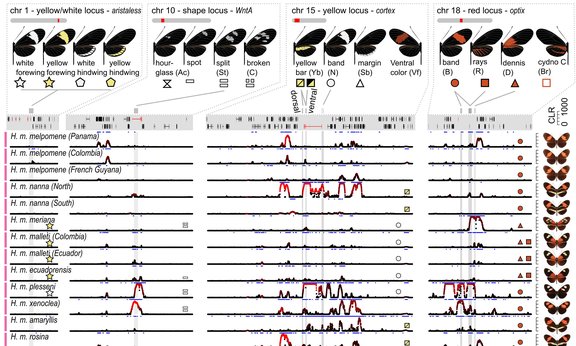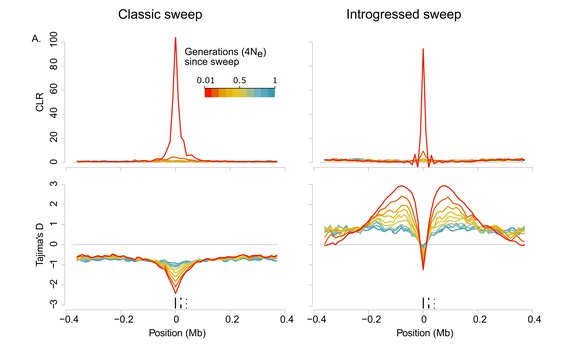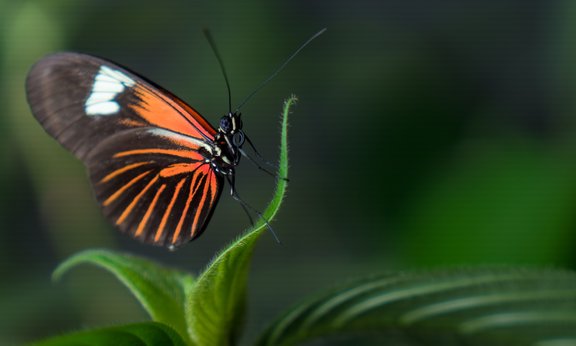The extremely bitter taste of Heliconius butterflies makes them inedible for birds. The natural predators have learned to interpret and avoid the typical pattern of the wings as a signal for distasteful prey. "As a result of evolutionary pressure, the warning colouration of various species has converged to each other through mutation but also through genetic exchange of regulatory elements. Young birds must first learn to associate this wing pattern with poisonousness. The more butterflies adopt the pattern, the higher the protective value of this pattern for an individual," said Markus Möst, who is studying Müller's mimicry in detail. Together with an international team, the evolutionary ecologist has investigated whether the wing patterns still change and show signs of recent selection and how these patterns differ among different species and populations of Heliconius. Contrary to the general assumption that this type of stabilizing selection should keep the wing patterns constant, this new study now shows that the process is quite dynamic and that the wing patterns keep changing.
The underlying genes
Heliconius butterflies are native to South and Central America. The Heliconius melpomene group and the Heliconius erato group have evolved from a common ancestor, but are genetically completely separated. Although they show different behaviours and use different pheromones to find a mate, they are visually hardly distinguishable from each othe. "Heliconius butterflies are a species-rich genus with diverse warning patterns and represent a so-called adaptive radiation. Genetically, however, the two groups, 'erato' and 'melpomene', are so far apart that they cannot hybridize anymore. Within the group, however, there are species such as H. melpomene and H. timareta that rarely, but still, cross and exchange wing pattern genes through a process known as adaptive introgression," said Möst. Heliconius scientists already have a pretty good idea about how those wing patterns are genetically encoded from numerous previous investigations. Four major sites in the genome, known as gene loci, which are encoding the typical patterns, were identified. "One locus for the red pattern, one for the yellow pattern, another defines the shape of the band on the forewing and a fourth can switch the yellow in the pattern to white," Möst explains. Mutations that generate new patterns happen frequently, but usually it takes a change in the selection pressure exerted on the patterns to allow a new pattern to rise in frequeny and fix. "Selecting for a locus usually also means that one variant is favoured over the others. Actually, this mechanism works against diversity in a population, because individuals carrying the advantageous variants thrive and outcompete others with less or dis- advantageous variants," says Möst.

Sweeping adaptation
In the study conducted by the scientists, about 600 individuals from 53 populations were genetically examined. These large numbers and diversity enabled the scientists to compare the populations with each other and to investigate whether the patterns have been static over extended periods of time or whether this is a dynamic process. "Despite Müllerian mimicry selection, these butterflies show a substantial and fascinating regional variation in their wing patterns. The aim of the study we conducted was to better understand how and when these variations developed," Möst explains. One possibility is new mutations and convergent evolution between species and populations of the Heliconius erato and Heliconius melpomene groups, but the exchange of existing patterns within groups is also known. For both cases, the researchers were able to detect so-called "selective sweeps", which indicate strong and recent positive selection, by sequencing and analysing the genomic regions containing the colour pattern genes. "The great variety of wing patterns in Heliconius has always fascinated scientists, because a stable warning pattern shared by all toxic species should actually confer the highest protection against predators. After analyzing the molecular data, we could see that it is not a stable system but actually quite dynamic," explains the ecologist. A "selective sweep" is always a sign of very strong, recent positive selection and indciates a rapid change in the genome that has only recently been fixed in the population. A strong fitness advantage can cause a variant to sweep and to become established in a population in just a few generations. "Positive selection can rapidly change the frequency of variants of a gene, so-called alleles, and leave detectable signatures in the genome. In our data, we were able to detect a surprisingly high number of sweeps, which also helps to explain the colour pattern variation observed in nature," says Möst. The various colour patterns in Heliconius melpomene and Heliconius erato are locally identical between the groups, as are many sweep patterns, but regionally different. How exactly these regional variations of the patterns arose, for example through differences in predation pressure, still remains an open question. "If one wants to understand the dynamics and strength of selection in the wild, in nature, one could observe populations over an extended period of time. However, since this is very time-consuming and often infeasible within a researcher's lifetime for many species, an elegant alternative is studying adaptive radiations like Heliconius butterflies. This way, we can learn more about the action of natural selection, how strong it is and how it may differ temporally and regionally," summarized Möst. With the data set generated in this study, the scientists now hope to pursue further evolutionary questions.

International cooperation
Markus Möst of the Institute for Ecology at the University of Innsbruck conducted this study in close cooperation with the laboratory of Chris D. Jiggins laboratory at the University of Cambridge and cooperated with colleagues worldwide. Steven Van Belleghem from the University of Puerto Rico and Jennifer James from the University of Arizona are the main authors of the study, along with the ecologist from Innsbruck. Camilo Salazar in Bogota and Simon H. Martin in Edinburgh have significantly supported the work with extensive sample material and bioinformatics expertise. Sarah Barker in Cambridge, Gilson Moreira in Porto Alegre, Claire Mérot in Quebec, Mathieu Joron in Montpellier, Nicola Nadeau in Sheffield and Florian Steiner, also from the Molecular Ecology group at the Institute of Ecology at the University of Innsbruck, have contributed significantly to the success of the study.
Publication: Selective sweeps on novel and introgressed variation shape mimicry loci in a butterfly adaptive radiation. Markus Moest, Steven M. Van Belleghem, Jennifer E. James, Camilo Salazar, Simon H. Martin, Sarah L. Barker, Gilson R. P. Moreira, Claire Mérot,Mathieu Joron, Nicola J. Nadeau, Florian M. Steiner,

